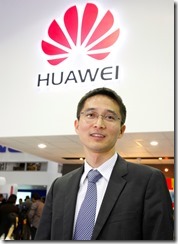In an exclusive interview with Comm., Bob Cai, Huawei VP of Wireless Network Marketing highlights the role being played by the technology provider in driving forward the mobile broadband success story and forecasts key developments that are set to define the further development of the industry in the coming years
Bob Cai is Huawei’s VP or Wireless Network Marketing
Bob Cai believes solutions such as Huawei’s SoftMobile are helping to drive the success of mobile broadband services globally. The company unveiled its SoftMobile solution for the first time in the Middle East in May, with the aim to help service providers build on-demand, orchestrated and ocean-like mobile broadband networks.
The solution helps operators create commercial opportunities by opening up the way for mobile broadband success.
According to Huawei, total revenue from subscriptions can be increased via the expansion of the number of connections beyond what is possible through today’s smartphones, creating a huge opportunity for operators to become enablers of innovation by opening up network functionality to third-parties developing applications to run across an expanding ecosystem.
Huawei believes that SoftMobile represents at least a US$2 trillion market opportunity for operators by 2020, with vertical market applications driving the uptake of mobile broadband.
“The revenue generated by mobile operators globally is set to more-than-double to US$2 trillion in 2020, up from US$800 million in 2012,” Cai says. “Much of this revenue increase will be driven by subscriber growth and the expansion of mobile digital services, for which there are a number of key success factors.”
Cai identifies access to a sufficient amount of the appropriate spectrum as one such success factor for mobile broadband development as well as experience in optimising networks and ensuring end-user behaviour is understood and catered for.
“Huawei’s SoftSwitch (SoftMobile) strategy is focussed on driving the benefits of the roll out of broadband networks with the provision of a ‘no-edge’ experience that requires the coordination between spectrum and technologies,” Cai explains. “It is also related to pushing forward innovation in order to drive down the total cost of ownership as well as the total variable cost of ownership,” he adds.
Huawei’s ‘no-edge’ experience aims to offer anytime, anywhere access to 5Mbps download speeds through the provision of indoor, metro (Wi-Fi), and macro networks.
SoftSwitch deployments are forecast to gain strong momentum from 2015 onwards with speeds of 5Mbps expected to become standard for the entire industry. The development of a single chipset that supports multiple bands and technologies has also become a reality, with 3G-enabled device shipments having surpassed 2G-enabled device shipments for the first time ever in 2013.
Cai also forecasts that the development of smart cities will be one of the vertical markets that will be a significant driver of mobile broadband services, with Huawei having recently showcased its smart city solution at the Third Smart City Expo World Congress, held in Barcelona in November. 
Huawei showcased its smart city strategy, explaining that the information highway of the future has four key pillars: A city-wide public information platform; ubiquitous broadband; smart and agile business; and comprehensive information security.
The machine-to-machine (M2M) opportunity is another vertical application that is expected to drive mobile broadband uptake with commonly quoted industry forecasts suggesting that as many as 50 billion connected devices will be in use by 2015, with the view being that machines that benefit from a connection to some network shall increasing be so. The global M2M service revenue is estimated to reach more than US$200 billion by 2017.
With respect to the ongoing development and take-up of mobile broadband services, Huawei expects revenues from LTE to amount to approximately US$2 billion in 2013, with UMTS (3G) remaining the larger component of mobile digital service revenues for the next coming couple of years. However, Cai believes operators need to continue to invest in their infrastructure in order to prepare for the exponential data growth that is set to take place in the years to come.
Huawei forecasts that its revenues from LTE sales will double in 2014 to at least US$4 billion, with the company having signed 241 LTE deployment contracts in total up to the end of November 2013. The company claims to have deployments in nearly half of the 244 commercially launched LTE networks worldwide, amounting to 110 deployments, compared to 100 from the next closest competitor, making it the largest winner of LTE contracts by contract volume so far in 2013.
“There are no limitations in hardware – more and more can be added as is necessary. Spectrum is the issue, and will be the limiting factor when it comes to mobile broadband growth, whether it’s TDD or FDD,” Cai advises.





0 comments ↓
There are no comments yet...Kick things off by filling out the form below.
Leave a Comment